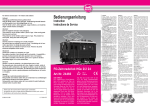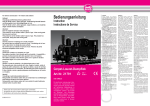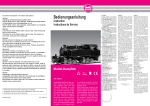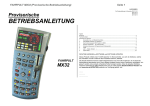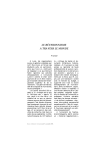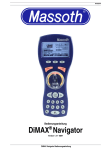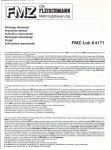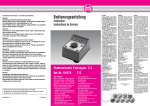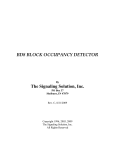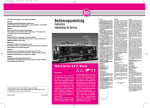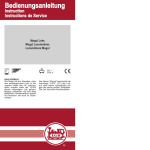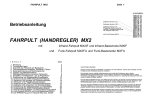Download Universal Remote
Transcript
• AUTORISIERTER SERVICE • AUTHORIZED SERVICE • CENTRES D’ENTRETIEN AUTORISÉS Bei unsachgemäßer Wartung wird ihre Garantie ungültig. Um fachgerechte Reparaturleistungen zu erhalten, wenden sie sich an ihren Fachhändler oder an die LGB-Service-Abteilung: Improper service will void your warranty. For quality service, contact your authorized retailer or one of the following LGB factory service stations: Un entretien inadéquat rendra la garantie nulle et non avenue. Veuillez entrer en contact avec votre revendeur ou avec l’un des centres d’entretien ci-dessous: Ernst Paul Lehmann Patentwerk Reparatur-Abteilung Saganer Straße 1-5 D-90475 Nürnberg DEUTSCHLAND Tel.: (0911) 83707 0 Telefax: (0911) 83707 70 • Die Einsendung erfolgt zu Ihren Lasten. • Informationen zu autorisierten LGB-Werkstätten in aller Welt finden sie im Internet unter www.lgb.de. 8.869110.212 Ernst Paul Lehmann Patentwerk Reparatur-Abteilung Saganer Strasse 1-5 D-90475 Nürnberg GERMANY Telephone: (0911) 83707 0 Fax: (0911) 83707 70 Ernst Paul Lehmann Patentwerk Reparatur-Abteilung Saganer Strasse 1-5 D-90475 Nuremberg ALLEMAGNE Téléphone : (0911) 83707 0 Fax : (0911) 83707 70 LGB of America Repair Department 6444 Nancy Ridge Drive San Diego, CA 92121 USA Telephone: (858) 535-9387 Fax: (858) 535-1091 LGB of America Repair Department 6444 Nancy Ridge Drive San Diego, CA 92121 États-Unis Téléphone : (858) 535-9387 Fax : (858) 535-1091 • You are responsible for any shipping costs, insurance and customs fees. • L’expéditeur est responsable des frais d’expédition, de l’assurance et des frais de douane. • Information on LGB products and LGB representatives around the world is available online at www.lgb.com • Conseil: Pour des renseignements au sujet des produits et des représentants LGB dans le monde, consultez le site web à www.lgb.com ➜ 55015 Universal-Handy · Universal Remote · Télécommande universelle 1 © DiskArt™ 1988 © DiskArt™ Wir garantieren 2 Jahre Fehlerfreiheit auf Material und Funktion. Berechtigte Beanstandungen innerhalb eines Jahres nach Kaufdatum werden kostenlos nachgebessert. Das beanstandete Produkt, zusammen mit dem Kaufbeleg, Ihrem Händler übergeben oder, ausreichend frankiert, an eine der beiden untenstehenden Serviceabteilungen einschicken: All of us at Ernst Paul Lehmann Patentwerk are very proud of this product. Ernst Paul Lehmann Patentwerk warrants it against defects in material or workmanship for two full years from the date of original consumer purchase. To receive warranty service, please return this product, along with the original purchase receipt, to an authorized retailer or to one of the LGB service stations listed here: Matériel et fonction sont entièrement garantis pour la période de deux an à partir de la date d’achat. Toutes les réclamations justifiées faites au cours de cette période, feront l’objet d’une réparation gratuite. Retourner le produit faisant l’objet de la réclamation, avec preuve de paiement, à votre distributeur, ou le renvoyer - en veillant à ce que l’affranchissement soit suffisant - à l’un des services après-vente ci-dessous: Das Universal-Handy The Universal Remote La télécommande universelle 2 Anschluss des Universal-Handys an Ihre Mehrzugsteuerung Connecting the Universal Remote to your Multi-Train System Raccordement de la télécommande universelle au système multitrain 6 Anschluss des Universal-Handys an den analogen Fahrregler 51070 Connecting the Universal Remote to the 51070 Analog Throttle Raccordement de la télécommande universelle à la commande analogique 51070 8 ERNST PAUL LEHMANN PATENTWERK Service-Abteilung Saganer Str. 1-5 · D-90475 Nürnberg Tel: (0911) 83 707 0 ERNST PAUL LEHMANN PATENTWERK Saganer Str. 1-5 · D-90475 Nürnberg GERMANY Telephone: (0911) 83 707 0 Einsetzen des LGB-Funkfernsteuerung-Senders und LGB-Empfängers Inserting the LGB Wireless Sender / Receiver Installation de l’ensemble émetteur/récepteur sans fil LGB 10 Betrieb mit dem Mehrzugsystem Operation with the Multi-Train System Utilisation avec le système multitrain 14 LGB OF AMERICA 6444 Nancy Ridge Drive San Diego, CA 92121 · USA Tel.: (858) 535-9387 LGB OF AMERICA 6444 Nancy Ridge Drive San Diego, CA 92121 · USA Telephone: (858) 535-9387 ERNST PAUL LEHMANN PATENTWERK Service-Abteilung Saganer Str. 1-5 · D-90475 Nürnberg ALLEMAGNE Tel: (0911) 83 707 0 Betrieb mit dem Analogfahrregler 51070 Operation with the 51070 Analog Throttle Utilisation avec la commande analogique 51070 40 Programmieren mit dem Universal-Handy Programming with the Universal Remote Programmation avec la télécommande universelle 48 Für Schäden durch unsachgemäße Behandlung oder Fremdeingriff besteht kein Garantieanspruch. This product will be repaired without charge for parts or labor. You are responsible for any shipping costs, insurance and customs fees. This warranty does not apply to products that have been damaged after purchase, misused or modified. Transformers and controls are subject to strict CE and UL regulations and may only be opened and repaired by the manufacturer. This warranty gives you specific legal rights, and you may also have other rights which vary from state to state. This warranty only applies to products purchased from authorized retailers. To find an authorized retailer, contact one of the LGB service stations listed here. LGB OF AMERICA Service Department 6444 Nancy Ridge Drive San Diego, CA 92121 · USA Tel: (858) 535-9387 Autorisierter Service Authorized Service Centres d’entretien autorisés 54 Transformatoren und Regler unterliegen strengen CE-ULVorschriften und dürfen nur vom Hersteller geöffnet und repariert werden. Zuwiderhandlungen bewirken zwingend Garantieverlust und generelle Reparaturverweigerung. Neben unserer Garantie, die wir zusätzlich gewähren, verbleiben selbstverständlich nach eigener Wahl die gesetzlichen Rechte. Viel Freude am Spiel mit unserem gemeinsamen Hobby. La garantie est nulle et non avenue en cas d’utilisation inadéquate ou d’intervention faite par une personne non autorisée. Les transformateurs et régulateurs sont conformes aux rigoureuses normes CE-UL et ne peuvent être ouverts et réparés que par le fabricant. Toute violation à cet égard entraînera la perte impérative de tous les droits de garantie et un refus de toutes réparations quelles qu’elles soient. Nous vous souhaitons des heures d’amusement inoubliables avec votre hobby qui est également le nôtre. ➜ LGB, LEHMANN und der LEHMANN TOYTRAIN-Schriftzug sind eingetragene Warenzeichen der Firma Ernst Paul Lehmann Patentwerk, Nürnberg, Deutschland. Andere Warenzeichen sind ebenfalls geschützt. © 2001 Ernst Paul Lehmann Patentwerk. LGB, LEHMANN and the LEHMANN TOYTRAIN logotype are registered trademarks of Ernst Paul Lehmann Patentwerk, Nürnberg, Germany. Other trademarks are the property of their owners. Products and specifications are subject to change without notice. © 2001 Ernst Paul Lehmann Patentwerk. LGB, LEHMANN et le logo LEHMANN TOYTRAIN sont des marques déposées de Ernst Paul Lehmann Patentwerk, Nuremberg, Allemagne. Les autres marques déposées sont la propriété de leurs détenteurs respectifs. Les produits et spécifications sont sujets à modifications sans préavis. © 2001 Ernst Paul Lehmann Patentwerk. 2 Das Universal-Handy The Universal Remote Le télécommande universelle 3 © DiskArt™ 1988 Das Universal-Handy bietet einen optimalen Bedienkomfort zur Steuerung Ihrer gesamten Mehrzugsteuerung. Das Universal-Handy kann auf Ihrer Mehrzugsteuerungsanlage und mit Einsatz der LGB-Funkfernsteuerung 55050/55055 auch an den analogen Fahrregler 51070 angeschlossen werden. Vom Universal-Handy aus können Sie folgende Funktionen steuern: Innerhalb der Mehrzugsteuerung: • Fahrtrichtung und Geschwindigkeit mit einstellbarem Regelbereich. • Direktes Auslösen der Zusatzfunktionen und des Lichts bei entsprechend ausgestatteten Loks. • Programmieren der Lokadressen 00-22. • Schalten und Programmieren von LGB-Weichendecodern. • Steuern und Programmieren von Fahrstrassen • Steuern und Programmieren von Doppeltraktionen • Wahlweise zur Funkfernsteuerung ausbaubar mit der LGB-Funkfernsteuerung 55050/55055. The Universal Remote offers convenient operation of your entire Multi-Train System. You can use the Universal Remote on your Multi-Train System layout or on a traditional analog layout, where you can connect it to the 51070 Analog Throttle (with 55050/55055 LGB radio control). With the Universal Remote, you can control the following functions: With the Multi-Train System, you can: • control direction and speed with adjustable throttle range • directly activate MTS functions and lights with MTS function-equipped locos • program decoder addresses 00-22 • operate and program LGB Switch Decoders. • operate and program switch routes. • operate and program doubleheading. • optional: operate your trains with wireless control with LGB radio control 55050/55055. La télécommande universelle est un moyen pratique de commande du système multitrain dans son ensemble. La télécommande universelle peut être utilisée sur un réseau numérique géré par le système multitrain ou sur un réseau analogique traditionnel où elle peut être raccordée à la commande analogique 51070 (avec l’ensemble émetteur/récepteur sans fil 55050/55055). La télécommande universelle permet de contrôler les fonctions suivantes : • Avec le système multitrain : • commande de la vitesse et du sens de la marche sur une plage réglable, • activation directe des fonctions SMT et de l’éclairage sur les locomotives équipées de ces fonctions, • programmation des adresses de décodeur 00-22 • commande et programmation des décodeurs d’aiguillage LGB, • commande et programmation des sections de réseau avec aiguillages, • commande et programmation de la double traction, • en option, configuration du réseau en commande sans fil par l’utilisation des ensembles émetteur/ récepteur sans fil 55050/55055. ➜ 4 Das Universal-Handy The Universal Remote Le télécommande universelle 5 © DiskArt™ 1988 In Verbindung mit dem analogen Fahrregler 51070: • Nur in Verbindung mit der LGB-Funkfernsteuerung 55050/55055 betriebsbereit. • Fahrtrichtung und Geschwindigkeit mit einstellbarem Regelbereich. Mit dem Universal-Handy können Sie alle LGBLokdecoder, den LGB-Funktiondecoder und den LGBWeichendecoder programmieren. With the Analog Throttle 51070, you can: • operate only with LGB radio control 55050/55055. • control direction and speed with adjustable throttle range With the Universal Remote, you can program all LGB loco decoders, the LGB function decoder and the LGB switch decoder. Avec la commande analogique 51070 : • fonctionnement uniquement avec l’ensemble émetteur/récepteur sans fil 55050/55055, • commande de la vitesse et du sens de la marche sur une plage réglable. La télécommande universelle permet de programmer tous les décodeurs pour locomotive LGB, le décodeur de fonction LGB et le décodeur d’aiguillage LGB. ➜ 6 Anschluß an Mehrzugsteuerung Connect to Multi-Train System Raccordement au système multitrain 7 © DiskArt™ 1988 Anschluss des Universal-Handys an Ihre Mehrzugsteuerung An Ihrem Universal-Handy befindet sich ein Anschlusskabel mit einem viereckigen Westernstecker am losen Kabelende. Diesen Westernstecker schließen Sie an der mit LGB-Bus markierten Buchse Ihrer MZS-Zentrale Typ 2 55005 an. Bei einem größeren Bedarf an Steckplätzen können Sie diese mit dem LGB-Adapter/Verteiler 55110 erweitern. Zum direkten Anschluss an Ihre Zentrale Typ 1 55000 verwenden Sie bitte den beigelegten Adapter für Westernstecker auf DIN Stecker (rund). Falls Sie hier noch andere Eingabegeräte verwenden möchten, verwenden Sie das Y-Kabel, das der Packung ebenfalls beigepackt wurde. Connecting the Universal Remote to your Multi-Train System A cable with a phone-style connector is attached to the Universal Remote. Plug the connector into an "LGB-Bus" socket on your 55005 MTS Central Station, Type 2. If you need more sockets, you can use the 55110 MTS Remote Adapter. To directly connect the remote to the 55000 Central Station, Type 1, please use the included adapter for DIN plugs (round). If you would like to use other input devices as well, use the Y cable, which also was included in the package. Raccordement de la télécommande universelle au système multitrain Un câble avec connecteur de type téléphone est branché sur la télécommande. Enficher le connecteur dans une prise identifiée «LGB Bus» sur le poste central type 2 55005. Si vous avez besoin de prises supplémentaires, vous pouvez utiliser l’adapteur SMT 55110. Pour raccorder directement la télécommande à un poste central type 1 55000, utiliser l’adapteur pour prises DIN (rondes) fourni. Pour raccorder d’autres dispositifs d’entrée, utiliser le câble en Y, également fourni. ➜ 8 51070 und 55050 51070 and 55050 51070 et 55050 9 © DiskArt™ 1988 Anschluss des Universal-Handys an den analogen Fahrregler 51070 Um das Universal-Handy hier einsetzen zu können benötigen Sie zwingend die LGB-Funkfernsteuerung 55050/55055. Lesen Sie hierzu den folgenden Abschnitt. 1 Einsetzen des LGB-FunkfernsteuerungSenders 55050 Für den Einsatz mit Funkfernsteuerung müssen Sie Ihr Universal-Handy mit einem RC-Sender 55050 ausrüsten. 1 Drücken Sie auf die beiden geriffelten Laschen am Kopfteil des Universal-Handys und ziehen Sie das Kunststoffteil mit Kabel vorsichtig heraus. 2 Setzen Sie in das nun offene Kopfteil den RCSender 55050 ein. Beschädigen Sie dabei nicht die Antenne. Connecting the Universal Remote to the 51070 Analog Throttle To use the Universal Remote in this setting, you must obtain the LGB radio control 55050/55055. For more information, read the following paragraph. Raccordement de la télécommande universelle à la commande analogique 51070 Vous devez utiliser l’ensemble émetteur/récepteur sans fil 55050/55055 pour pouvoir utiliser la télécommande universelle avec la commande analogique 51070. Pour de plus amples renseignements, se reporter au paragraphe suivant. Inserting the 55050/55051 LGB Wireless Transmitter For wireless operation, you have to equip your Universal Remote with a 55050/55051 Wireless Transmitter. 1 Press both textured clips at the top of the remote inward and carefully pull out the plastic insert. 2 Slide the 55050/55051 Wireless Transmitter into the remote. Do not damage the antenna while doing this. Installation de l’émetteur sans fil LGB 55050/55051 Pour la configuration commande sans fil, il est impératif d’installer un émetteur sans fil 55050/55051 sur la télécommande universelle. 1 Déplacer les deux boutons en relief situés à la partie supérieure de la télécommande vers l’intérieur et sortir l’insert plastique avec précaution. 2 Enficher l’émetteur sans fil 55050/55051 dans la télécommande. Faire très attention à ne pas endommager l’antenne pendant l’opération. 2 ➜ 10 55050 55050 55050 11 © DiskArt™ 1988 3 Öffnen Sie das Batteriefach am Schnappverschluss an der Unterseite Ihres Universal-Handys und legen Sie vier Mignon (AA) Batterien nach Aufdruck in das Batteriefach. Verwenden Sie hochwertige Batterien, z.B. Alkali Batterien. Schließen Sie das Batteriefach. Eingeschaltet wird das Universal-Handy durch längeres Drücken der Taste F auf dem Tastaturfeld Ihres Universal-Handys. Wenn bei Betrieb die obere Kontrollleuchte blinkt, dann ist dies ein Zeichen dafür, dass Sie Ihre Batterien wechseln sollen. Entsorgen Sie verbrauchte Batterien bitte umweltgerecht. Um beim Betrieb Strom zu sparen, können Sie durch Drücken der Taste F und gleichzeitiges Drücken der Taste 9 das konstant leuchtende Anzeigendisplay auf einen 3 Sec. Modus einstellen (gleiches Vorgehen, wenn Sie wieder auf konstante Anzeige umschalten wollen). Nach längerer Phase ohne Eingabe schaltet sich das Handy selbstständig ab. 3 Open the battery compartment using the clip on the underside of the remote and insert 4 ”AA” batteries, as shown on the battery cover. Use high-quality batteries, like "alkaline" batteries. Close the battery compartment. Turn on the Universal Remote by pressing the ”F” button on the button pad of your Universal Remote for a significant period of time. If during operation, the upper LED is flashing, you should change the batteries. Please dispose of used batteries with consideration to the environment. To save energy during operations, you can change the constantly illuminated display to a 3 second mode by simultaneously pressing buttons ”F” and ”9”. (Use the same method to switch back to constant display.) After a significant time without inputs, the remote switches off automatically. 3 Utiliser le bouton situé sous la télécommande pour ouvrir le couvercle du logement des piles et installer 4 piles de type «AA», comme il est indiqué sur le couvercle. N’utiliser que des piles de qualité supérieure, comme les piles «alcalines». Remettre le couvercle du logement des piles en place. Mettre la télécommande sous tension en enfonçant le bouton «F» du clavier de la télécommande et en le maintenant enfoncé pendant un bon moment. Si pendant l’utilisation de la télécommande, la DEL supérieure clignote, c’est qu’il faut remplacer les piles. Se débarrasser des piles en suivant les réglementations en vigueur. Pour économiser l’énergie pendant l’utilisation de la télécommande, vous pouvez ramener la durée d’allumage de l’afficheur, qui est normalement toujours allumé, à 3 secondes en appuyant simultanément sur les boutons «F» et «9» (Répéter l’opération pour revenir en mode d’allumage permanent). La télécommande passe automatiquement hors tension après une période d’inactivité assez longue. ➜ 3 12 55050 und 55055 55050 and 55055 © DiskArt™ 1988 Nach Beendigung des Spielens, können Sie durch Drücken der Taste F und gleichzeitiges Drücken der Taste 0 das Universal-Handy wieder ausschalten. Wenn Sie über einen längeren Zeitraum nicht spielen möchten, empfiehlt es sich die Batterien aus dem Batteriefach zu nehmen. Bitte beachten Sie, dass Ihre Funkfernsteuerung nur eine einseitige Befehlrichtung hat, und Sie deshalb keine Rückantwort erhalten. 4 Ihr Universal-Handy ist nun für den jeweiligen Einsatz bereit. After you have finished playing, you can turn off the Universal Remote by simultaneously pressing the buttons ”F” and ”0.” If you don’t plan to play for a significant period of time, it is recommended to take the batteries out of the battery compartment. Please note that your radio control system has a one-way command direction. Therefore, you don’t get confirmations. 4 Now your Universal Remote is ready for operation. 5 Anschluss des RC-Empfängers 55055 Lesen Sie hierzu die Bedienungsanleitung des RCEmpfängers 55055. 5 Connecting the 55055/55056 Wireless Receiver You’ll find this information in the instructions for the 55055/55056 Wireless Receiver. 55050 et 55055 13 4 Vous pouvez mettre la télécommande hors tension après utilisation en appuyant simultanément sur les boutons «F» et «0». Nous recommandons de sortir les piles lorsque la télécommande n’est pas utilisée pendant une longue période. Il ne faut pas oublier que le système de commande par radio fonctionne de manière unidirectionnelle, il n’y a donc pas de confirmation des instructions de commande. 4 La télécommande est maintenant prête pour être utilisée. 5 5 Installation du récepteur sans fil 55055/55056 Les instructions d’installation du récepteur sans fil 55055/55056 figurent sur la fiche d’instructions de l’accessoire. ➜ 14 Betrieb mit dem MZS Operation with the MTS Utilisation avec le SMT 15 © DiskArt™ 1988 Betrieb mit dem Mehrzugsystem Auf der Tastatur Ihres Universal-Handy finden Sie einer jeden Zahl ein Symbol zugeordnet. Jedes dieser Symbole entspricht einer gewissen Funktion. Um zwischen diesen Funktionen agieren zu können, müssen Sie über die Taste “F” und dem jeweiligen Symbol auswählen. Sie bedienen als erstes die Taste “F” dann eine Taste von “1-8”. Nachdem Sie die Taste “F” gedrückt haben, zeigt Ihnen eine gelbe Kontrollleuchte über der Taste “F” das Sie im Funktionswechsel sind. Ebenso werden durch Blinken des Kennbuchstaben in der Anzeige die jeweiligen Schaltvorgänge dargestellt. Operation with the Multi-Train System On the button pad of your Universal Remote, you find a symbol next to each number. Each of these symbols represents a certain function. To select one of these functions, press the ”F” button and the corresponding symbol button. First press the ”F” button and then one of the numbered buttons ”1-8.” After you have pressed the ”F” button, the yellow LED above the ”F” button shows that you are now in the ”function changing mode.” In the same manner, a flashing of the letter in the display indicates each command. Utilisation avec le système multitrain Un symbole figure sur le clavier de la télécommande universelle, à côté de chaque numéro. Chaque symbole représente une fonction particulière. Pour sélectionner l’une de ces fonctions, appuyer sur le bouton «F» et sur le bouton avec le symbole correspondant. Appuyer tout d’abord sur le bouton «F» et ensuite sur l’un des boutons numérotés «1-8». Appuyer sur le bouton «F», la DEL jaune située au-dessus du bouton «F» s’allume pour indiquer que la télécommande est maintenant en «mode de changement de fonction». De la même manière, le clignotement de la lettre sur l’afficheur indique chaque commande. ➜ 16 17 © DiskArt™ 1988 1 Weichen und andere EPL-Antriebe oder Zubehör schalten. Sobald Sie das Universal-Handy einschalten oder über die Taste “F” und “1” gedrückt haben, erscheint in der Anzeige S - . Durch weitere Eingabe der Weichennummer (oder Antriebs bzw. Zubehör Nummer) wählt man den jeweiligen Artikel an. Über die Pfeil-Tasten in der unteren Hälfte des Bedienfeldes schaltet man je nach Artikel auf geradeaus oder abzweigen, rot oder grün, ein oder aus. Wechselt man auf eine ungültige Adresse springt die Anzeige zurück auf S - und man beginnt erneut. 1 Setting switches and other EPL drives or accessories After the remote is plugged in or after you have pressed the buttons ”F” and ”1,” the display shows S -. Enter the switch number (or number of drive or accessory) you want to set. Press the arrow buttons in the lower half of the button pad to set the item to straight or diverging, red or green, on or off. If you select an invalid address, the display shows S - . Start anew. 1 Réglage des aiguillages et autres dispositifs d’entraînement ou accessoires EPL Brancher la télécommande ou appuyer sur les boutons «F» et «1», l’afficheur indique S - . Entrer le numéro de l’aiguillage (ou du dispositif d’entraînement ou de l’accessoire) à régler. Appuyer sur les boutons fléchés situés à la moitié inférieure du clavier pour régler l’aiguillage ou le dispositif d’entraînement ou l’accessoire : la position de l’aiguille, droite ou virage, rouge ou vert, marche ou arrêt. L’afficheur indiquera S - en cas de sélection d’adresse incorrecte. Recommencer l’opération. ➜ 02-55015 RZ_1. Teil S. 02-21 19.10.2001 11:25 Uhr Seite 9 18 19 © DiskArt™ 1988 2 Loks Steuern Drücken Sie die Taste “F” und die Taste “2”. In der Anzeige erscheint dann die letzte eingestellte Loknummer L xx . Um die Loknummer zu wechseln, drücken Sie die Taste “0”, es erscheint L - - auf der Anzeige, geben Sie dann die neue Loknummer zweistellig ein (00 – 22). Bei einer zu hohen Loknummer springt die Anzeige wieder auf L - - . Falls die gewählte Lokadresse von einem Mitspieler belegt wird, erlischt die rote Kontrollleuchte über der Anzeige. Der Mitspieler muss dann entweder seine Lok frei geben, in dem er die Adresse bei sich wechselt, oder er den Regler ca. 4 sec auf Null stellt. Über die Pfeiltasten im unteren Bedienfeld können Sie Ihre Loks fahren lassen. Die rechte Pfeiltaste lässt Ihre Loks vorwärts fahren, die linke Pfeiltaste lässt Ihre Loks rückwärts fahren. 2 Controlling locomotives Press the buttons ”F” and ”2.” The last selected loco number is displayed: L xx . To change the loco number, press ”0,” now the display shows L -- , then input the new two-digit loco address (00-22). If your loco number is too high, the display shows L -- again. If the new address is already in use by another player, the red LED above the display goes dark. The other player must either release the loco by selecting a different address on their MTS throttle or by setting the throttle to zero for about 4 seconds. By pressing the arrow buttons in the lower half of the button pad you can run your loco’s. The right arrow button is used to run the loco foreward, the left arrow button is used to run backwards. 2 Commande des locomotives Appuyer sur les boutons «F» et «2». La dernière adresse de locomotive sélectionnée apparaît sur l’afficheur sous la forme L xx . Pour changer le numéro de la locomotive, appuyer sur le bouton «O», l’afficheur indique maintenant L -- , entrer les deux chiffres de la nouvelle adresse de la locomotive (00-22). En cas de sélection d’une adresse incorrecte (supérieure à 22), la télécommande passe automatiquement en mode de sélection d’adresse : L -- . Si la nouvelle adresse est déjà utilisée par un autre joueur, la DEL rouge située au-dessus de l’afficheur s’assombrit. L’autre joueur doit libérer la locomotive en sélectionnant une adresse différente sur sa commande SMT ou en ramenant la commande au zéro pendant environ 4 secondes. Vous pouvez faire fonctionner la locomotive en utilisant les boutons flèchés à la partie inférieure du clavier. Le button flèche à droite fait déplacer la locomotive vers l’avant et le bouton flèche à gauche la fait déplacer vers l’arrière. ➜ 20 21 © DiskArt™ 1988 2 Lokbeleuchtung Über die Taste “9” können Sie die Beleuchtung Ihrer Lok ein und auch wieder ausschalten. Vorrausetzung ist, dass Ihre Lok digitalisiert ist und dabei das Licht auf den richtigen Schaltausgang installiert wurde. Sonderfunktionen Über die Tasten “1” bis “8” können Sie die Sonderfunktionen Ihrer Loks aufrufen. Vorrausetzung ist, dass Ihre Lok digitalisiert ist und Sonderfunktionen hat. 2 Loco lights Using button ”9,” you can switch on and off the lights of your loco. This works only if your loco is digitalized and if the lights were installed on the correct terminal. Special functions Using buttons ”1” through ”8,” you can trigger special functions of your locos. This works only if your loco is digitalized and equipped with special functions. 2 Feux des locomotives Appuyer sur le bouton «9» pour allumer et éteindre les feux de la locomotive. Ce bouton ne peut être utilisé que si la locomotive est numérisée et que les feux sont raccordés à la broche appropriée. Fonctions spéciales Les boutons «1» à «8» servent pour la commande des fonctions spéciales des locomotives. Ces boutons ne peuvent être utilisés que si la locomotive est numérisée et équipée des fonctions spéciales. ➜ 22 23 © DiskArt™ 1988 3 Fahrstrassen schalten Hier können Sie die von Ihnen selbst zusammengestellten Fahrstrassen schalten. Fahrstrassen sind eine Reihe von Artikeln, vorwiegend Weichen (Signale können mit berücksichtigt werden), welche miteinander beschaltet einen bestimmten Fahrweg für Loks herstellen. Sie haben die Auswahl aus bis zu 10 Fahrstrassen (0-9). Wie immer drücken Sie die Taste “F”, dann die Taste “3”. In der Anzeige erscheint F Geben Sie dann die Nummer der Fahrstrasse ein, welche Sie stellen wollen. Auch hier gilt, bei falscher Eingabe springt die Anzeige auf F - zurück. Beachten Sie bitte, dass Ihre Fahrstrasse nur einen Befehl nach dem Anderen abarbeitet. D.h. bei längeren Fahrstrassen (max. 15 Schaltvorgänge) kann es etwas Dauern bis alles gestellt ist. Während dieser Zeit dürfen Sie nicht die Taste “F” drücken, da sonst der Vorgang abgebrochen wird. Ebenfalls wird bei einem zwischenzeitlichen Nothalt der Stellvorgang unterbrochen und erst wieder bei deaktivieren des Nothalts fortgesetzt. 3 Setting switch routes In this mode, you can set your own switch routes, which you have compiled. Switch routes are a number of items, mostly switches (signals can be considered as well), which are set together to create a route for the loco. You have a selection of up to 10 switch routes (0-9). As usual, press the ”F” button, then the ”3” button. The display shows F Enter the number of the switch route you want to set. Here, too, the following holds true: With an invalid input, the remote selects F - . Please note that the switch route is processed one element at a time. For long switch routes (up to 15 commands to individual elements), this can take a while. Don’t press the ”F” button while setting a switch route, otherwise the process is terminated. The same applies for an emergency stop: The setting process is interrupted and will be continued only after the emergency stop has been deactivated. 3 Établissement des sections de réseau avec aiguillages Ce mode permet d’établir des sections de réseau avec aiguillages. Les sections de réseau avec aiguillages représentent un nombre d’éléments, en particulier des aiguillages (le principe est le même pour les signaux), regroupés pour créer un itinéraire pour une locomotive. Le nombre de sections de réseau avec aiguillages peut atteindre 10 (0-9). Appuyer sur le bouton «F», puis sur le bouton «3». L’afficheur indique F - . Entrer le numéro de la section de réseau avec aiguillages sélectionnée. En cas d’entrée incorrecte, la télécommande repasse en mode de sélection F - . Bien se rappeler que les éléments sont traités les uns après les autres, ce qui veut dire que pour les sections de réseau avec aiguillages de grande longueur (jusqu’à 15 commandes vers les éléments individuels), l’opération peut prendre du temps. Ne pas appuyer sur le bouton «F» tant que l’opération n’est pas terminée, car cela désactive le processus. Le même raisonnement s’applique en cas d’arrêt d’urgence. Le processus est interrompu et ne reprendra qu’après la désactivation de l’arrêt d’urgence. ➜ 24 25 © DiskArt™ 1988 4 Doppeltraktion ansteuern Eine Doppeltraktion ist ein Verbund von zwei Lokomotiven, welcher gerne für besonders lange Züge oder auch für Steigungen eingesetzt wird. Sie sollten jedoch darauf achten, dass die von Ihnen ausgewählten Loks von den Geschwindigkeiten her ungefähr gleich sind. Unterschiedliche Tempos können Getriebeschäden hervorrufen. Achten Sie auch darauf, dass beide Loks in der von Ihnen programmierten Richtung auf dem Gleis stehen, da Sie sonst gegeneinander fahren. Wie immer rufen Sie diese Funktion über die Taste “F” auf, und ergänzen die Taste “4”. Dann erhalten Sie die Anzeige d x . Auch hier haben Sie die Auswahl von 0-9. Falls Sie eine ungültige Traktionsnummer aufgerufen haben wechselt die Anzeige wieder auf d - . Mit den Pfeiltaste steuern Sie nun den aufgerufenen Lokverbund als eine Traktionsnummer, wobei die Sonderfunktionen dann von beiden Loks ausgeführt werden. 4 Controlling doubleheading Doubleheading means connecting two locomotives to a train. This is used for especially long trains and also for uphill grades. However, you should make sure that the locos you have selected are approximately the same as far as their speed is concerned. Different speeds can cause gearbox damage. Also make sure that the locos are oriented in the programmed direction. Otherwise, they will run in opposite directions. As always, you call up this function by pressing ”F” and add the button ”4.” The display shows d x . Here, too, you have a choice between 0-9. If you select an invalid number, the remote displays d - again. Now use the arrow buttons to control both locos together as one traction number. Special functions are executed by both locos. 4 Commande de la double traction La double traction signifie que deux locomotives sont raccordées au même train. Cette technique est utilisée en particulier pour tirer les longs convois et également pour monter les fortes pentes. Il faut toutefois s’assurer que les locomotives choisies possèdent des caractéristiques identiques, en particulier en ce qui concerne la vitesse, car il y a un risque d’endommagement de la boîte de vitesses dans le cas contraire. Il ne faut pas non plus oublier de vérifier que les locomotives sont orientées suivant le sens de la marche programmé, sinon elles se déplaceront dans des sens contraires. Appuyer sur le bouton «F», puis sur le bouton «4». L’afficheur indique d - . Entrer un numéro compris entre «0» et «9». En cas d’entrée incorrecte, la télécommande repasse en mode de sélection d - . Utiliser les boutons fléchés pour commander les deux locomotives comme un seul ensemble de traction. Les fonctions spéciales seront exécutées par les deux locomotives. ➜ 26 27 © DiskArt™ 1988 5 Identifikationsnummer = ID# Jedes Gerät, welches mit dem LGB-Daten-Bus verbunden ist. Bekommt eine sogenannte ID#. Auch Ihr Universal-Handy. Bei Auslieferung ist Ihr UniversalHandy auf ID 1 eingestellt. So sollte es eigentlich auch bleiben. Sie sollten jedem Gerät Ihrer Mehrzugsteuerung eine ID# zuweisen, sofern es einstellbar ist. Sie haben die Möglichkeit von ID 1 bis ID 7, wobei die ID 1 und die ID 2 öfters auf Befehle abgerufen werden als folgende (besitzen Sie noch eine ältere Zentrale aus der ersten Generation, können nur ID 1 und ID 2 behandelt werden). Sollten Sie Probleme haben beim Weichenschalten, ist meist die ID# Ihres Universal-Handy verstellt. Um die ID# einzustellen, drücken Sie die Taste “F” und dann die Taste “5”. In der Anzeige erscheint dann P - . Geben Sie dann Ihre ausgewählte ID# ein, die Anzeige wechselt automatisch in die davor eingestellte Funktion. 5 Identification Number = ID# Each device connected to the LGB Data BUS. Receives an ID Number. Same for your Universal Remote. At the factory, your Universal Remote is programmed to ID 1. And it should remain that way. You should assign each device of your Multi-Train System an ID#, if it is adjustable. You can choose from ID 1 through ID 7, but ID 1 and ID 2 are more often checked for commands than the following (if you own an older Central Station from the first generation, only ID 1 and ID 2 can be covered). If you have problems setting switches, usually the ID# of your remote has been changed. To program the ID#, press the ”F” button and then the ”5” button. The display shows P - . Enter your selected ID#, the display automatically changes to the previously selected function. 5 Numéro d’identification – ID # Chaque dispositif raccordé au bus de données LGB reçoit un numéro d’identification. C’est la même chose pour la télécommande universelle. Le numéro d’identification attribué en usine à la télécommande universelle est ID1, et il doit le rester. Chaque élément du système multitrain doit avoir un numéro d’identification, s’il est possible de le changer. Le choix va de ID1 à ID7, mais ID1 et ID2 sont les plus souvent utilisés pour les commandes (en ce qui concerne le poste central de première génération, seuls ID1 et ID2 peuvent être utilisés). En cas de difficultés pour le réglage des aiguillages, vérifier que le numéro d’identification de la télécommande n’a pas été changé. Pour programmer le numéro d’identification, appuyer sur le bouton «F», puis sur le bouton «5». L’afficheur indique P - . Entrer le numéro d’identification choisi, l’afficheur repasse automatiquement à la fonction sélectionnée précédemment. ➜ 28 29 © DiskArt™ 1988 6 Reaktionszeit der Pfeiltasten programmieren Mit Ihren Pfeiltasten, im unteren Bereich des UniversalHandy, können Sie die Geschwindigkeit Ihrer Lok Ihrer Lok erhöhen, indem Sie mehrmals auf die rechte Pfeiltaste drücken oder konstant darauf bleiben. Um Ihren Loks somit eine Anfahrverzögerung zu geben, können Sie den Zeitwert zwischen den einzelnen Impulsen des Handy verändern. Von schneller Beschleunigung (0,3 sec zwischen den Impulsen), bis langsamer Beschleunigung (1,2 sec zwischen den Impulsen). Die Werte hierfür sind von 1 bis 7. Um die Loks abzubremsen, gilt der selbe wert für die linke Pfeiltaste. Der runde Knopf in der Mitte bremst die Loks auch mit selben Verzögerung bis Stillstand. Zum Programmieren drückt man die Taste “F” und die Taste “6”. Die Anzeige zeigt P - . Danach gibt man seinen Wert von 1 bis 7 ein, und die Anzeige wechselt von selbst in die davor eingestellte Funktion. 6 Programming the reaction time of the arrow buttons With your arrow buttons, located in the lower part of the Universal Remote, you can increase the speed of your loco of your loco by pressing the right arrow button several times or holding it constantly. Thus, to give your loco a starting delay, you can program the time value between the individual impulses of the remote. From fast acceleration (0.3 sec. between impulses) to slow acceleration (1.2 sec. between impulses). The values for this are 1 through 7. To slow the locos, the same value applies for the left arrow button. The round button in the center brakes the locos, also with the same deceleration, until they stop. To program, one presses the ”F” button and the ”6” button. The display shows P - . After that, one inputs one’s value between 1 and 7, and the display changes to the previously selected function. 6 Programmation du temps de réaction des boutons fléchés Les boutons fléchés situés à la partie inférieure de la télécommande universelle permettent d’augmenter la vitesse de la locomotive. Pour ce faire, appuyer plusieurs fois sur le bouton de droite ou le maintenir enfoncé. Donc, pour programmer une temporisation au démarrage, programmer la durée entre les impulsions de la télécommande. Pour une accélération rapide, utiliser 0,3s entre impulsions et pour une accélération lente, utiliser 1, 2s entre impulsions. Cette plage correspond aux chiffres 1 à 7. Le même principe s’applique avec le bouton de gauche pour ralentir la locomotive. Le bouton rond au centre déclenche le freinage, avec la même décélération, jusqu’à l’arrêt. Pour programmer, appuyer sur le bouton «F», puis sur le bouton «6». L’afficheur indique P - . Entrer le numéro choisi, entre 1 et 7, l’afficheur repasse automatiquement à la fonction sélectionnée précédemment. ➜ 30 31 © DiskArt™ 1988 7 Fahrstrassen programmieren Hier können Sie die von Ihnen selbst zusammengestellten Fahrstrassen programmieren. Es besteht die Möglichkeit bis zu 10 Fahrstrassen anzulegen. Eine jede der Fahrstrassen kann bis zu 15 Elemente (Weichen, Signale, etc.) beinhalten. Beispiele für Fahrstrassen sind einzelne Bahnsteige, bestimmte Wege um von einem äußeren in einen inneren Kreis zu fahren usw. Um zu Programmieren drücken Sie die Taste “F” und die Taste “7”. In der Anzeige erscheint P - . Geben Sie nun die Nummer der Fahrstrasse ein (0 bis 9). Die Anzeige zeigt wieder P - . Geben Sie die Nummer des ersten Elements ein-, zwei- oder dreistellig ein (1 bis 128) 7 Programming switch routes Here you can program your switch routes which you have assembled. You can assemble up to 10 switch routes. Each switch route can contain up to 15 elements (switches, signals, etc.). Examples for switch routes are individual platforms, certain paths to go from an outer circle into an inner circle, etc. To program, press the ”F” button and the ”7” button. The display shows P - . Enter the switch route number (0 through 9). The display shows P - again. Enter the number of the first element of the switch route (one, two or three digits, 1 through 128) 7 Programmation des sections de réseau avec aiguillages Vous pouvez programmer les sections de réseau avec aiguillages qui ont été constituées. Le nombre de sections de réseau avec aiguillages peut atteindre 10, et chaque section peut comporter jusqu’à 15 éléments (aiguillages, signaux, etc.). Parmi les sections de réseau courantes, citons les quais individuels, les passages d’un cercle extérieur à un cercle intérieur, etc. Pour programmer, appuyer sur le bouton «F» et sur le bouton «7». L’afficheur indique P - . Entrer le numéro de la section de réseau (0 à 9). L’afficheur indique de nouveau P - . Entrer le numéro du premier élément de la section de réseau avec aiguillages (un, deux, ou trois chiffres de 1 à 128 inclus). ➜ 32 33 © DiskArt™ 7 Fahrstrassen programmieren Eine der Pfeiltasten für die Stellrichtung drücken, dabei müssen Sie folgendes beachten: < Linksweiche abzweigen Rechtsweiche gerade Signal grün > Linksweiche gerade Rechtsweiche abzweigen Signal rot Die Anzeige zeigt wieder P - . Dies können Sie nun für 15 Elemente wiederholen, dann springt die Anzeige wieder auf die voreingestellte Funktion zurück. Bei weniger als 15 Elementen drücken Sie die Tast “F” und eine andere Funktion und haben damit die Programmierung abgeschlossen. 7 Programming switch routes Press one of the arrow buttons for the direction, in which the element is switched: < for: left switch diverging, right switch straight signal green > for: left switch straight, right switch diverging, signal red The display shows P - again. Now you can repeat this for 15 elements. Then the display returns to the previously selected function. If the switch route has less than 15 elements, press the ”F” button and another function to end the programming. If the switch route has 15 elements, the remote automatically re-selects the previous mode. 7 Programmation des sections de réseau avec aiguillages Appuyer sur l’un des boutons fléchés correspondant à la direction du trafic suivant la position de l’aiguillage : < aiguillage à gauche en position de virage, aiguillage à droite en position tout droit, feu au vert, > aiguillage à gauche en position tout droit, aiguillage à droite en position de virage, feu au rouge. L’afficheur indique de nouveau P - . Répéter l’opération pour tous les 15 éléments de la section de réseau, L’afficheur revient à la fonction sélectionnée précédemment. Si la section de réseau comporte moins de 15 éléments, appuyer sur le bouton «F» et sur un autre bouton de fonction pour terminer la programmation. Si la section de réseau comporte 15 éléments, la télécommande sélectionne automatiquement le mode précédent. ➜ 34 35 © DiskArt™ 8 Doppeltraktion programmieren Sie können bis zu 10 Lokkombinationen aus je zwei Loks programmieren. Sie drücken wieder die Taste “F” und dann die Taste “8”. Die Anzeige zeigt P - . Sie geben die Nummer der Kombination ein (0 bis 9). Die Anzeige zeigt nun P - - . Jetzt geben Sie die Adresse der 1.Lok zweistellig ein (00 – 22). Die Anzeige zeigt wieder P - - . Jetzt folgt die Adresse der 2. Lok wieder zweistellig (00 – 22). Die Anzeige zeigt P - . 8 Programming doubleheading You can program up to 10 loco combinations with 2 loco addresses each. Press the ”F” button again and then the ”8” button. The display shows P - . Enter the loco combination number (0 through 9). The display now shows P - - . Enter the first two-digit loco address (00 - 22). The display shows P - - . Enter the second loco address, also with two digits (00 - 22). The display shows P - . 8 Programmation de la double traction Vous pouvez, au maximum, programmer 10 combinaisons de locomotives, chaque combinaison ayant 2 adresses. Appuyer sur le bouton «F», puis sur le bouton «8». L’afficheur indique P - . Sélectionner le numéro de combinaison (0-9). L’afficheur indique maintenant P - - . Sélectionner l’adresse à deux chiffres de la première locomotive (00-22). L’afficheur indique de nouveau P - - . Sélectionner l’adresse de la deuxième locomotive, également à deux chiffres (00-22). ➜ 36 37 © DiskArt™ 8 Doppeltraktion programmieren Jetzt müssen Sie die Fahrtrichtung der Loks zueinander bestimmen. Sie haben dafür vier Auswahlmöglichkeiten (0 – 3). 0 beide Loks fahren in gleicher Richtung. 1 die 1. Lok fährt in umgekehrter Fahrtrichtung 2 die 2. Lok fährt in umgekehrter Fahrtrichtung 3 beide Loks fahren in gleicher Fahrtrichtung aber andersherum. 8 Programming doubleheading Now you have to determine the direction of travel. You have four choices (0-3): 0 Both locos go in the same direction. 1 Loco 1 goes in the opposite direction. 2 Loco 2 goes in the opposite direction. 3 Both locos go in the same direction, but the other way. 8 Programmation de la double traction L’afficheur indique «P-» une fois les adresses sélectionnées. Choisir maintenant le sens de la marche des locomotives, vous avez quatre choix (0-3) : 0 les deux locomotives se déplacent dans la même direction. 1 La locomotive n°1 se déplace dans la direction opposée. 2 La locomotive n°2 se déplace dans la direction opposée. 3 Les deux locomotives se déplacent dans la direction opposée. ➜ 38 39 © DiskArt™ Nothalt Mit Ihrem Universal-Handy können Sie über die “STOP” Taste einen Nothalt oder eine Pause auslösen. Drücken Sie die “STOP” Taste und Ihre Schienen sind sofort stromlos. Dies wird Ihnen durch Blinken der oberen Kontrollleuchte am Universal-Handy signalisiert (nicht mit Fernbedienung). Ein weiteres Drücken auf die “STOP” Taste hebt die Unterbrechung wieder auf. Falls Sie sich verdrückt haben, muss die Kontrollleuchte mindestens dreimal geblinkt haben um die Unterbrechung wieder zu deaktivieren. Um einen Unfall auf Ihrer Anlage vorzubeugen, falls zwei Loks auf Kollisionskurs waren, drücken Sie auf Ihrer Zentrale die Reset-Taste bevor Sie den Nothalt wieder deaktivieren. Emergency Stop With your Loco Remote, you can use the ”STOP” button to trigger an emergency stop or a pause. Press the ”STOP” button, and track power to your layout is switched off immediately. Now the red LED at the top of the remote flashes (not with wireless operation). Press the ”STOP” button once more to restart. If you have pressed the button in error, the LED has to flash at least three times to deactivate the interruption. To prevent an accident if two trains were about to collide, press the ”Reset” button on the Central Station before you deactivate the emergency stop. Arrêt d’urgence Appuyer sur le bouton «STOP» de la télécommande universelle pour déclencher un arrêt d’urgence ou une pause. Appuyer sur le bouton «STOP» et l’alimentation électrique de la voie est coupée immédiatement. La DEL rouge située à la partie supérieure de la télécommande clignote (ce n’est pas le cas en configuration commande sans fil). Appuyer de nouveau une fois sur le bouton «STOP» pour remettre en route après un arrêt d’urgence. Si vous appuyez sur le bouton par erreur, la DEL doit clignoter au moins trois fois avant de pouvoir remettre en route. Pour éviter une collision imminente entre deux trains, appuyer sur le bouton «Reset» du poste central avant de faire repartir les locomotives. ➜ 40 Betrieb mit 51070 Operation with 51070 Utilisation avec 51070 41 © DiskArt™ Betrieb mit dem Analogfahrregler 51070 Um das Universal-Handy hier einsetzen zu können benötigen Sie zwingend die LGB-Funkfernsteuerung 55050/ 55055 (siehe vorhergehende Kapitel). Falls beim Anschluss des Universal-Handys, an den analogen Fahrregler, keine Anzeige im Display sichtbar ist, muss das Handy über die Taste “F” eingeschaltet werden. Da Sie die Möglichkeit haben, mehrere analoge Fahrregler 51070 anzusteuern, müssen Sie nach dem Einschalten Ihren Stromkreis auswählen. Wenn Sie nur einen Stromkreis haben, und die Grundeinstellungen Ihres RC-Empfängers 55055 nicht verändert haben, ist Ihr zu wählender Stromkreis die Nummer 1. Der letzt angewählte Stromkreis wird in der Anzeige als L xx (XX ist die Nummer des Stromkreises) dargestellt. Um den Stromkreis zu ändern, drücken Sie bitte die Taste “0”, dann erscheint L - - in der Anzeige. Geben Sie die neue Nummer ( 01 bis 08) zweistellig ein. Der neugewählte Stromkreis wird in der Anzeige dann dargestellt. Operation with 51070 Analog Throttle To use the Universal Remote in this application, you must obtain the LGB radio control 55050/55055 (see previous chapter). If after connecting the Universal Remote to the Analog Throttle, no display is visible, you must switch on the remote using button ”F.” Because you can control several 51070 Analog Throttles, you have to select your track block after the power is turned on. If you have only one throttle, and you have not changed the settings of your 55055/55056 Wireless Receiver, select track block No. 1. The last track block you selected is displayed as L xx (xx is the number of the track block). To change the track block, please press button ”O,” then the display shows L - - . Input the new two-digit number (01 through 08). Then the newly selected track block is displayed. Utilisation avec la commande analogique 51070 Pour utiliser la télécommande universelle avec la commande analogique 51070, il est nécessaire d’utiliser l’ensemble émetteur/récepteur sans fil LGB 55050/55055 (se reporter au chapitre précédent). Si aucune indication n’apparaît sur l’afficheur après raccordement de la télécommande à la commande analogique, mettre la télécommande sous tension en utilisant le bouton «F». La télécommande permettant de commander plusieurs commandes analogiques 51070, vous devez sélectionner la partie de réseau à contrôler après la mise sous tension du système. S’il n’y a qu’une commande et que les réglages du récepteur 55055/55056 n’ont pas été modifiés, sélectionnez la partie de réseau n°1. La dernière partie de réseau sélectionnée est affichée sous le format L xx (xx est le numéro de la partie du réseau). Pour changer le numéro de la partie de réseau, appuyer sur le bouton «0», l’afficheur indique L - - . Entrer le nouveau numéro à deux chiffres (01 à 08), le nouveau numéro de partie de réseau sélectionnée s’affiche. ➜ 42 43 © DiskArt™ Fahrtrichtung und Geschwindigkeit Über die Pfeiltasten im unteren Bedienfeld können Sie Ihre Loks fahren lassen. Die rechte Pfeiltaste lässt Ihre Loks vorwärts fahren, die linke Pfeiltaste lässt Ihre Loks rückwärts fahren. Direction of travel and speed Using the arrow buttons in the lower button pad, you can operate your locos. Press the right arrow button to move the loco forward, the left arrow button to move it backwards. Reaktionszeit der Pfeiltasten programmieren Mit Ihren Pfeiltasten, im unteren Bereich des UniversalHandy, können Sie die Geschwindigkeit Ihrer Lok Ihrer Lok erhöhen, indem Sie mehrmals auf die rechte Pfeiltaste drücken oder konstant darauf bleiben. Um Ihren Loks somit eine Anfahrverzögerung zu geben, können Sie den Zeitwert zwischen den einzelnen Impulsen des Handy verändern. Von schneller Beschleunigung (0,3 sec zwischen den Impulsen), bis langsamer Beschleunigung (1,2 sec zwischen den Impulsen). Die Werte hierfür sind von 1 bis 7. Um die Loks abzubremsen, gilt der selbe Wert für die linke Pfeiltaste. Der runde Knopf in der Mitte bremst die Loks auch mit selben Verzögerung bis Stillstand. Programming the reaction time of the arrow buttons With your arrow buttons, located in the lower part of the Universal Remote, you can increase the speed of your loco by pressing the right arrow button several times or howlding it constantly. Thus, to give your loco a starting delay, you can program the time value between the individual impulses of the remote. From fast acceleration (0.3 sec. between impulses) to slow acceleration (1.2 sec. between impulses). The values for this are 1 through 7. To slow the locos, the same value applies for the left arrow button. The round button in the center brakes the locos also with the same deceleration until they stop. To program, one presses the ”F” button and the ”6” button. The display shows ”P -.” After that, one inputs one’s value between 1 and 7, and the display changes to the previously selected function. Sens de la marche et vitesse Utiliser les boutons fléchés à la partie inférieure du clavier pour faire fonctionner les locomotives. Appuyer sur le bouton flèche droite pour déplacer la locomotive vers l’avant et sur le bouton flèche gauche pour déplacer la locomotive vers l’arrière. Programmation du temps de réaction des boutons fléchés Les boutons fléchés situés à la partie inférieure de la télécommande universelle permettent d’augmenter la vitesse de la locomotive. Pour ce faire, appuyer plusieurs fois sur le bouton de droite ou le maintenir enfoncé. Donc, pour programmer une temporisation au démarrage, programmer la durée entre les impulsions de la télécommande. Pour une accélération rapide, utiliser 0,3s entre impulsions et pour une accélération lente, utiliser 1, 2s entre impulsions. Cette plage correspond aux chiffres 1 à 7. Le même principe s’applique avec le bouton de gauche pour ralentir la locomotive. Le bouton rond au centre déclenche le freinage, avec la même décélération, jusqu’à l’arrêt. Pour programmer, appuyer sur le bouton «F», puis sur le bouton «6». L’afficheur indique «P-». Entrer le numéro choisi, entre 1 et 7, l’afficheur repasse automatiquement à la fonction sélectionnée précédemment. ➜ 44 45 © DiskArt™ 1988 Stop-Taste Mit Ihrem Universal-Handy können Sie über die “STOP” Taste einen Nothalt oder eine Pause auslösen. Drücken Sie die “STOP” Taste und Ihre Schienen sind sofort stromlos. Ein weiteres Drücken auf die “STOP” Taste hebt die Unterbrechung wieder auf. Falls Sie die “STOP” Taste versehentlich gedrückt haben, müssen Sie ca. 3 bis 4 sec. Warten bis Sie über nochmaliges Drücken den Nothalt wieder deaktivieren können. Stop button With your Universal Remote, you can use the ”STOP” button to trigger an emergency stop or a pause. Press the ”STOP” button, and track power to your layout is switched off immediately. Press the ”STOP” button once more to restart. If you have pressed the button in error, you have to wait for 3 to 4 seconds until you can deactivate the emergency stop by pressing the button again. Bouton d’arrêt Vous pouvez utiliser le bouton «STOP» de la télécommande universelle pour déclencher un arrêt d’urgence ou une pause. Appuyer sur le bouton «STOP» et l’alimentation électrique de la voie est coupée immédiatement. Appuyer de nouveau une fois sur le bouton «STOP» pour remettre en route après un arrêt d’urgence. Si vous appuyez sur le bouton par erreur, vous devez attendre de 3 à 4 secondes avant de pouvoir désactiver l’arrêt d’urgence en appuyant de nouveau sur le bouton. ➜ 46 Programmieren mit dem Universal-Handy Programming with the Universal Remote Programmaton avec le télécommande universelle 47 © DiskArt™ 1988 Programmieren mit dem Universal-Handy Sie können mit Ihrem Universal-Handy auch Lokdecoder , MZS-Funktionsdecoder für Wagen und LGB-Weichendecoder programmieren. Um mit dem Universal-Handy programmieren zu können, entfernen Sie aus dem Kopfteil des Handy den Einsatz mit dem schwarzen Kabel bzw. den LGBRC-Sender. Drücken Sie auf die beiden geriffelten Laschen am Kopfteil des Universal-Handys und ziehen Sie das Kunststoffteil vorsichtig heraus. Setzen Sie in das nun offene Kopfteil den mitgelieferten Programmiereinsatz ein. Programming with the Universal Remote You can also use your Universal Remote to program loco decoders, MTS Rolling Stock Decoders and LGB Switch Decoders. To be able to program with the Universal Remote, remove the insert with the black cable or the LGB Wireless Transmitter from the top of the remote. Press both textured clips at the top of the remote inward and carefully pull out the plastic insert. Now slide the enclosed programming insert into the remote. Programmation avec la télécommande universelle La télécommande universelle peut également être utilisée pour programmer les décodeurs pour locomotive, les décodeurs pour matériel roulant SMT et les décodeurs d’aiguillage SMT. Pour pouvoir programmer avec la télécommande universelle, enlever l’insert avec le câble noir ou l’émetteur sans fil LGB de la partie supérieure de la télécommande. Déplacer les deux boutons en relief situés à la partie supérieure de la télécommande vers l’intérieur et sortir avec précaution l’insert en plastique. Enficher l’insert de programmation fourni dans la télécommande. ➜ 48 49 © DiskArt™ 1988 Am Programmiereinsatz finden Sie vier verschiedenfarbige Kabel. Diese vier Kabel teilen sich auf in zwei Kabel (grün und gelb) die Sie mit dem Trafo verbinden, und zwei Kabel (braun und weiß) die Sie direkt mit dem LGBWeichendecoder oder über ein stromloses Programmiergleis mit den Loks und Wagen verbinden. Der Trafo sollte min. 2A haben. Am besten eignet sich Ihr Trafo, den Sie zur Steuerung Ihr Mehrzuganlage verwenden. Wir empfehlen den Wechselstromtrafo 50110. Erst wenn Sie den Aufbau komplett haben, verbinden Sie den Trafo mit dem Netz. On the programming insert, you will see four colorcoded wires. These four wires are split into two wires (green and yellow), which you’ll connect to the transformer, and two wires (brown and white), which you’ll connect directly to the LGB switch decoder or via an unpowered programming track to the locos and cars. The transformer should have at least 2 amps. Best is your transformer which you use to control your MultiTrain System layout. We recommend the 50110/50111 AC transformer. 7 Only after you have completed the setup, connect the transformer to a house current outlet. 6 L’insert de programmation comporte quatre fils de couleur différente. Les fils vert et jaune doivent être connectés au transformateur et les fils brun et blanc doivent être connectés directement au décodeur d’aiguillage LGB ou par l’intermédiaire d’une voie de programmation non alimentée électriquement aux locomotives et voitures ou wagons. Le transformateur doit avoir une sortie minimum de 2A. Le meilleur transformateur est celui utilisé pour le système multitrain. Nous recommandons les modèles à courant alternatif 50110/50111. La préparation est maintenant terminée, brancher le transformateur dans une prise de courant dans la maison. ➜ 50 51 © DiskArt™ Die Programmierung geht dann immer den selben Schritt. Aus der Bedienungsanleitung der jeweiligen Decoder suchen Sie sich die Register oder CV´s (CV = Configuration Variable) heraus, die Sie ändern wollen. Als Beispiel die Adresse der Lok oder des Wagens oder des Weichendecoders. Dieses Register ist bei allen gleich, es ist Register (oder CV) 1. Sie haben in der Anzeige P - - . Sie geben das Register ein. Hier 1. Die Anzeige zeigt P - 1 . Dann geben Sie den neuen Wert ein. Bei der Lokadresse z.B. 05 Die Anzeige zeigt dann P - 5 . Um die Programmierung zu speichern drücken Sie dann die rechte Pfeiltaste . Falls Sie sich unsicher sind bei der Werteingabe, können Sie mit der linken Pfeiltaste die Programmierung abrechen. Starten Sie dann wieder von Vorn. Jeder einzelne Programmiervorgang eines Register funktioniert wie unser kleines Beispiel. The programming then always happens according to these steps. Look in the instructions for the decoder and find the register or CV (CV - Configuration Variable) you would like to change. For example, the address of the loco or the car or the switch decoder. This register is the same for all, it is register (or CV) 1. You see the display showing P - - . Enter the register number. Here 1. The display shows P - 1 . Then enter the new value. For the loco address, e.g., 05. Press the right arrow button ">" to save the programming. If you are not sure about the value you have input, you can use the left arrow button "<" to abort programming. Restart from the beginning. Each individual programming of a register works like our little example. La programmation se fait toujours dans l’ordre suivant. Consulter la fiche d’instructions du décodeur et trouver le registre ou la variable de configuration (CV) que vous voulez changer. Par exemple, l’adresse de la locomotive, de la voiture ou du wagon ou du décodeur d’aiguillage. Ce registre est le même pour tous, il s’agit du registre (ou du CV) 1. L’afficheur indique P - - . Entrer le numéro du registre, ici 1. L’afficheur indique P - 1 . Entrer maintenant la nouvelle valeur, 05, par exemple pour une adresse de locomotive. Appuyer sur le bouton flèche droite «>» pour sauvegarder la programmation. En cas de doute sur la valeur entrée, utiliser la flèche gauche «<» pour arrêter la programmation et recommencer l’opération depuis le début. L’exemple illustré est valable pour la programmation individuelle de chaque registre. ➜ 52 © DiskArt™ Weitere Informationen über das LGB-Mehrzugsystem wie z.B. Einbauvorschläge für Decoder, finden Sie in der LGBDepesche und im LGB-Telegram, sowie unter www.lgb.de Achtung! Um Sicherheit und Zuverlässigkeit zu gewährleisten, betreiben sie das Produkt nur mit LGBTrafos und Fahrreglern. Bei Verwendung von anderen Trafos wird ihre Garantie ungültig. Weitere Informationen über die LGB-Trafos und Fahrregler zur Verwendung im Haus oder im Freien und über das Mehrzugsystem finden sie im LGB-Katalog. Dieses Produkt ist nicht für Kinder unter 8 Jahren geeignet. Bewahren sie Verpackung und Bedienungsanleitung auf. In the LGB Depesche and LGB Telegram magazines, as well as online at www.lgb.de, you find additional information about the LGB Multi-Train System, such as installation suggestions for decoders. Attention! For safety and reliability, operate this product with LGB power supplies (transformers, power packs and controls) only. The use of non-LGB power supplies will void your warranty. For more information on LGB power supplies for indoor, outdoor and multi-train operation, see the LGB catalog. This product is not for children under 8 years of age. Save the supplied packaging and instructions. Les magazines LGB Depesche et LGB Telegram, ainsi que le site Internet de LGB .de contiennent des renseignements supplémentaires au sujet du système multitrain de LGB, comme par exemple des suggestions d’installation pour les décodeurs. Attention ! Pour des raisons de sécurité et de fiabilité, n'utiliser que les blocs d’alimentation LGB (transformateurs, groupes d’alimentation et commandes) pour faire fonctionner ce produit. L’utilisation de blocs d’alimentation autres que les blocs d’alimentation LGB rendra la garantie nulle et non avenue. Se reporter au catalogue général LGB pour des renseignements complémentaires au sujet des blocs d’alimentation LGB pour utilisation à l’intérieur, à l’extérieur et pour le système multitrain. Ce produit n’est pas pour les enfants en dessous de 8 ans. Conserver l’emballage et les instructions.





























